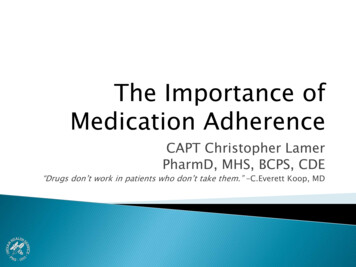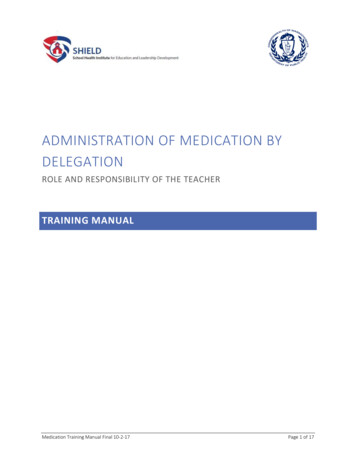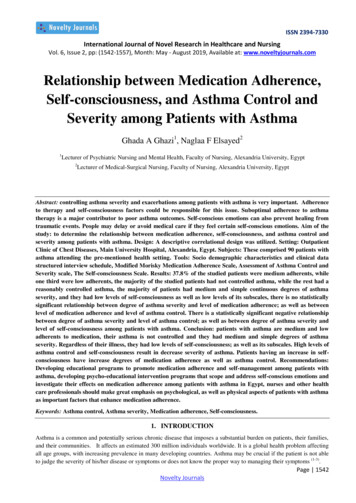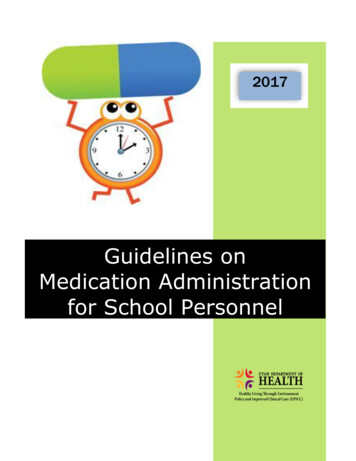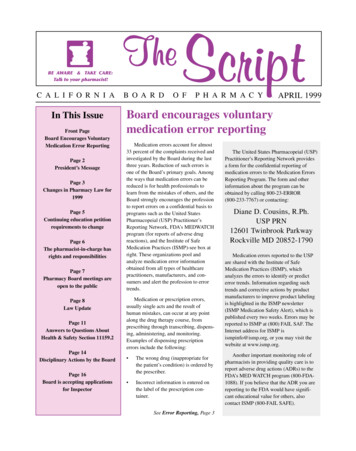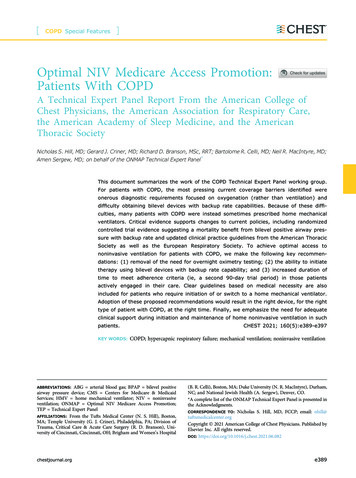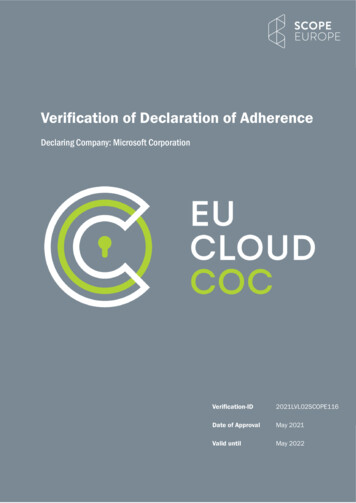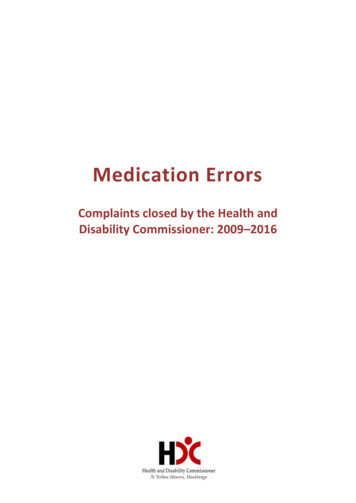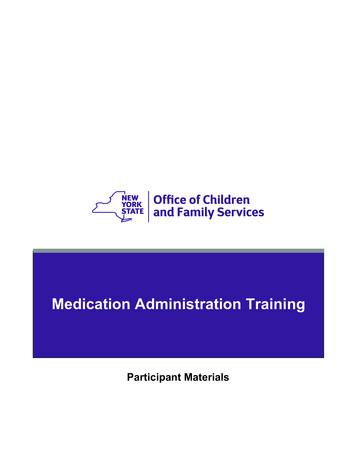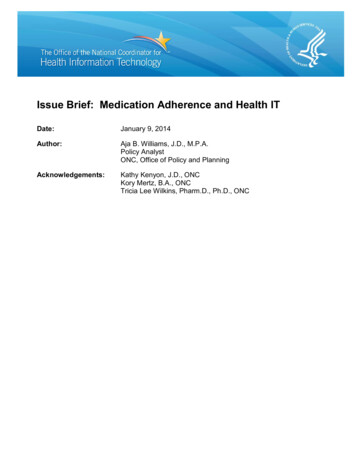
Transcription
Issue Brief: Medication Adherence and Health ITDate:January 9, 2014Author:Aja B. Williams, J.D., M.P.A.Policy AnalystONC, Office of Policy and PlanningAcknowledgements:Kathy Kenyon, J.D., ONCKory Mertz, B.A., ONCTricia Lee Wilkins, Pharm.D., Ph.D., ONC
Table of ContentsWhat’s the Issue?. 3Changing View of Medication AdherenceMeasuring Medication AdherenceHealth OutcomesEconomic ImpactWhat Has Happened So Far? . 6Meaningful Use and Certified EHR AdoptionElectronic PrescribingDrug FormularyMedication List/ReconciliationNorth Carolina HIE: PHARMACeHOMEElectronic Drug MonitoringPredictive ModelingSouthern Piedmont Beacon Community: Closing the Gap!Substitutable Medical Apps, Reusable Technologies (SMART) PlatformConsumer eHealth ToolsSoutheast Michigan Beacon Program: Patient Health Navigator InitiativeHawai‘i HIE: Pharm2PharmVideo Challenge/Txt4healthWhat Are the Opportunities and Challenges? . 11What’s Next? . 12ONC Issue Brief: Medication Adherence and Health IT2
“Drugs don’t work in patients who don’t take them.”– C. Everett Koop, MDThere seems to be agreement that medication adherence is important, can improve health, andreduce costs. Innovations in health information technology (health IT) present an opportunity toincrease medication adherence rates, measure medication adherence, improve care, improveoverall population health, and reduce health care costs.Today, vendors are increasing the number of consumer facing tools to assist in the selfmanagement of health conditions. Medication adherence, specifically the lack thereof, presentsan opportunity for the health IT community to develop solutions and tools that supportmedication adherence to improve the quality of life and health of millions of Americans. Withoutthe use of information technology (IT), measuring medication adherence can be onerous, withfeasibility and cost being barriers. Innovations in health IT can increase the feasibility ofmonitoring, accuracy, and widespread usage of medication adherence tools.This brief provides an overview of medication adherence and how implementing health IT canincrease adherence rates that support wellness and population health. HHS, via the Office ofthe National Coordinator for Health Information Technology (ONC) and the Centers forMedicare & Medicaid Services (CMS), is supporting medication adherence and medicationmanagement through a variety of activities, including the meaningful use of certified electronichealth records (EHRs) and through the Medicare and Medicaid EHR Incentive Program. Inaddition, this brief identifies challenges pertaining to reliable metrics and the expansion ofconsumer-based tools that encourage patient and caregiver participation in medicationadherence.What’s the Issue?Changing View of Medication AdherenceThere is a changing view of medication adherence.Medication adherence commonly refers to the “extent towhich a patient takes medications as prescribed by theirhealth care provider,” 1 specifically, their conformance totiming, dosage and frequency of medications taken during aprescribed length of time. 2Adherence implies mutualengagement on the part ofthe provider, the patient,and their caregiver thatresults in consensusregarding the patient’streatment regimen.- Ho, et alHowever, some have suggested that this definition assumesa passive role of patients and that medication adherence requires a more active role forproviders, patients, and caregivers. According to Facilitating Treatment Adherence: APractitioner’s Guidebook, “Adherence is the active, voluntary, and collaborative involvement ofthe patient in a mutually acceptable course of behavior to produce a therapeutic result.” 3 In thisinstance, medication adherence implies mutual engagement on the part of the provider, patient,Meichenbaum D and Turk DC. Facilitating Treatment Adherence: A Practitioner's Guidebook. New York: Plenum Press, 1987.Viswanathan M, Golin CE, Jones CD, Ashok M, Blalock S, Wines RCM, Coker-Schwimmer EJL, Grodensky CA, Rosen DL, Yuen A,Sista P, Lohr KN. Medication Adherence Interventions: Comparative Effectiveness. Closing the Quality Gap: Revisiting the State ofthe Science. Evidence Report No. 208. (Prepared by RTI International–University of North Carolina Evidence-Based Practice Centerunder Contract No. 290-2007-10056-I.) AHRQ Publication No. 12-E010-EF. Rockville, MD: Agency for Healthcare Research andQuality. September 2012. nal.cfm.3 Meichenbaum and Turk.12ONC Issue Brief: Medication Adherence and Health IT3
and caregiver that results in consensus regarding the patient’s treatment regimen. 4 Medicationadherence, in this view, is a dynamic practice that is part of an ongoing collaboration, ratherthan a static activity determined unilaterally by a health care provider.The Surgeon General has identified three categories for non-adherence:(1) primary non-adherence (occurs when patient does not obtain prescribed medication)(2) discontinuation (occurs when a patient stops taking a prescription too early); and(3) compromised execution (patients who are actively engaged in therapy, but use medicationinconsistent with provider instructions, i.e. skipping dosages and splitting pills).Health IT can support a more engaged approach to medication adherence by supportingconsumer decision-making and coordination between patients and health care providers.Measuring Medication AdherenceDespite the existence of many effective medical treatments, the Institute of Medicine reporteddiscrepancies between the projected estimates for treatment success rates and actual treatmentoutcomes. 5 “This gap has been attributed partly to lack of patient adherence to recommendedtreatment.” 6 The Agency for Health Research and Quality (AHRQ) attributed low medicationadherence rates to: (1) poor communication between the provider and patient/caregiver; (2)socioeconomic barriers for the patient; (3) and complexity of medication regimen prescribed. 7 Ifleft unchecked, the high prevalence of medication non-adherence may have a substantial anddetrimental impact on U.S. population health and economy.Absent the use of IT, measuring medication adherence can be costly, labor-intensive and mayproduce unreliable results. There are a number of methods used to measure medicationadherence and these methods are categorized as either direct or indirect. 8,9 “Direct methodsinclude: taking medication in the presence of a health care provider, measuring the level ofmedicine or metabolite in blood or measuring biological markers in blood, once a prescription istaken.” 10 Indirect methods include: pill counts, self-report, patient diaries, pharmacy refill data,electronic medication monitors, and other telemedicine devices. While direct measures areconsidered by some to be more reliable and accurate than indirect measures, most agree thatdirect methods are too burdensome and not practical for routine clinical use. 11Human interventions that once required direct patient contact can now be performedelectronically using health IT. For instance, with the advent of video conferencing andsmartphone applications, patients, caregivers and providers are now able to monitor medication4 Ho, P, Bryson C, and Rumsfeld J. "Medication Adherence: It’s Importance in Cardiovascular Outcomes." [In eng]. Circulation 119,no. 23 (Jun 16 2009): 3028-35.5 Priority Areas for National Action: Transforming Health Care Quality. Summary of Institute of Medicine report. Agency forHealthcare Research and Quality. Rockville, MD: January 2003. http://www.ahrq.gov/qual/iompriorities.pdf6 Viswanathan M, Golin C, Jones C, Ashok M, Blalock, Roberta CM Wines, Emmanuel JL Coker-Schwimmer, et al. "Interventions toImprove Adherence to Self-Administered Medications for Chronic Diseases in the United States: A Systematic Review." Annals ofInternal Medicine 157, no. 11 (2012): 785-95.7 Viswanathan, et al. Medication Adherence Interventions: Comparative Effectiveness.8 Osterberg L and Blaschke T. "Adherence to Medication." [In eng]. N Engl J Med 353, no. 5 (Aug 4 2005): 487-97.9 This is not in reference to compliance. Compliance implies “submissive behavior” of complying with a provider’s will and order.Researchers have recognized that a patient-centered approach that builds on the patient’s strengths and choices is more effective atachieving adherence. Adherence’ implies more of a collaborative, active role between patients and their providers.10 Ho, et al.11 Id.ONC Issue Brief: Medication Adherence and Health IT4
adherence through video-logged confirmation of dosage. Using health IT increases thefeasibility of monitoring medication adherence and promotes technological innovations that areconsumer-facing to improve self-management.Health OutcomesMedication non-adherence poses a threat to public health and increases costs of health care. Inthe United States, it is estimated that lack of adherence causes approximately 125,000 deathsand at least 10% of hospitalizations. 12 Half of the 3.2 billion annual prescriptions dispended inthe U.S. are not taken as prescribed. 13 This number is even lower among patients with chronicconditions. Chronic conditions persist over a length of time andare among the most costly and preventable of all healthproblems in the U.S. 14 The Centers for Disease Control andHalf of the 3.2 billionannual prescriptionsPrevention (CDC) reported that 75 percent of health caredispended in the U.S. areexpenditures are used for the treatment of chronic disease.not taken as prescribed.Non-adherence occurs with greater frequency in persons- Osterberg andsuffering from multiple chronic conditions and among thoseBlaschketaking multiple medications.Economic ImpactEvidence suggests that medication adherence programs have the potential to reduce healthspending and generate significant savings for taxpayers. The IMS Institute for HealthcareInformatics estimated that implementing improvements in medication adherence could mitigate 105.4 billion in avoidable costs. On average, non-adherent patients have higher health costsper year: 3,700 for diabetes, 3,900 for hypertension, and 7,800 for congestive heart failure.Adherence to diabetes medications alone could save 4.7 billion. 15In November 2012, the Congressional Budget Office (CBO) released a report announcing achange in the agency’s estimating methodologies that attributes cost savings to legislation thatdirectly affects the quantity of prescriptions filled. The agency relied on analysis thatdemonstrated a link between changes in prescription drug use and spending for medical servicespertaining to the Medicare Part D drug benefit program:“For example, a policy that increased prescription drug copayments forcertain Medicare beneficiaries might save 4 billion in federal drug costsin a given year but reduce the number of prescriptions filled that year by 1percent. That reduction in use would result in a one-fifth of 1 percentincrease in the affected population’s total spending for medical services. Ifthat total spending would otherwise be 250 billion in that year, thenthose costs would increase by 0.5 billion. The net effect of the policy,Viswanathan, et al. "Interventions to Improve Adherence to Self-Administered Medications for Chronic Diseases in the UnitedStates: A Systematic Review."13 Osterberg and Blaschke.14 "Chronic Diseases and Health Promotion." Centers for Disease Control and iew/index.htm.15 Roebuck MC, Liberman JN, Gemmill-Toyama M, and Brennan TA. Medication Adherence Leads To Lower Health Care Use AndCosts Despite Increased Drug Spending. Health Affairs. January 1, 2011: 30(1):91-99.12ONC Issue Brief: Medication Adherence and Health IT5
combining the savings on drug costs of increased use of medical services,would be a saving for the federal government of 3.5 billion in that year.” 16Essentially, CBO’s new method incorporates offsets or savings from decreases in medicalservices, which had not been previously recognized.What Has Happened So Far?Meaningful Use and Certified EHR AdoptionInnovations in health IT and higher adoption and use of certified EHRs present opportunities toreduce medication non-adherence. The Health Information Technology for Economic andClinical Health (HITECH) Act established financial incentives for eligible hospitals and healthcare professionals to adopt and meaningfully use certified EHRs. The "meaningful use" of anEHR refers to the use of certified EHR technologies by health care providers in ways thatmeasurably improve health care quality and efficiency.Under the Medicare and Medicaid EHR Incentive Program, CMS has developed objectives andmeasures that eligible hospitals and health care professionals must meet in order to receiveincentive payments. ONC has established the standards and certification criteria to ensure thatcertified EHR technology is capable of meeting certain minimum requirements necessary tosupport these actions by providers.CMS has included objectives that support medication adherence, such as: generating andtransmitting electronic prescriptions; exchanging key clinical information among providers;providing patients with electronic access to their health information (including medication lists);enabling automated clinical decision support; and implementing drug formulary checks. 17Electronic PrescribingElectronic-prescribing (e-prescribing) is the electronic generation, transmission, and filling of aprescription. E-prescribing provides an opportunity for the provider to monitor a patient’smedication regimen. A 2013 article in Health Affairs attributed increases in e-prescribing tofederal incentives: “Between 2008 - 2010, federal incentives resulted in 89,000 - 94,000 more newe-prescribers, than there would have been otherwise. The data suggest that among providerswho were already e-prescribing, the federal incentive program was associated with a 9 - 11percent increase in the use of the e-prescribing- equivalent to additional 6.8 - 8.2 e-prescriptionsper provider per month.” 18 In 2011, the National Progress Report on E-prescribing andInteroperable Health Care found one in two office-based physicians used e-prescribing, versusone in ten circa 2008. Likewise, the report found e-prescribing increases medication first filladherence by 10 percent with the potential to save 140 - 240 billion over the next 10 years. 1916 Congressional Budget Office. "Offsetting Effects of Prescription Drug Use on Medicare’s Spending for Medical Services."Congressional Budget Office (CBO), 2012. .17 Not an exhaustive list.18 Joseph SB, Sow MJ, Furukawa MF, Posnack S, and Daniel JG. "E-Prescribing Adoption and Use Increased Substantially Followingthe Start of a Federal Incentive Program." [In eng]. Health Affairs (Millwood) 32, no. 7 (Jul 2013): 1221-7.19 The National Progress Report On E-Prescribing and Interoperable Health care. Surescripts. (2011)ONC Issue Brief: Medication Adherence and Health IT6
There is value in an e-prescribing system that makes it easier to fill a prescription and to assureits accuracy. However, there is also an opportunity for health IT to facilitate provider-patientcommunications through automatic notification of unfilled prescriptions, which can trigger anintervention to avoid gaps in medication usage. 20Drug FormularyIn Medication Adherence Interventions: Comparative Effectiveness, AHRQ concluded that policyinterventions that reduce out-of-pocket costs improved adherence. Likewise, the authors ofUsing Health Information Technology to Determine Medication Adherence identified prescriptioncost as a factor of non-adherence. A drug formulary refers to a comprehensive list ofmedications, generic and name-brand that are approved under a specific health plan. Thepurpose of the formulary is to reduce overall cost for medications to the insurer and the patient,while safely and effectively treating the health condition or concern at a minimum cost.Generally, drugs prescribed outside a health plan’s formulary result in increased costs ofmedications. In April 2013, CMS released data that showed drug formularies are among themost popular (optional) menu objectives for eligible providers in the first phase of the Medicareand Medicaid EHR Incentive Program. Subsequently, as this program progresses into its nextphase, drug formulary checks will move from an optional menu item to a core objective. Utilizinghealth IT to generate formularies presents providers and patients with the opportunity to makeinformed decisions by optimizing medication choice. Optimizing choice of medications supportsefforts to improve medication adherence at the time a prescription is first filled.Medication List/ReconciliationThe average hospital patient is subject to at least one medication error per day. 21 Health IT canfacilitate medication adherence by supplying providers, patients, caregivers, and other membersof the care team with complete medication list. An active medication list serves multiplepurposes and is used during reconciliation. Reconciliation is the process of avoiding inadvertentinconsistencies during transitions in care by reviewing the patient's complete medicationregimen at the time of admission, transfer, and discharge, then comparing it with the regimenbeing considered in the new setting. 22 For example, Stage 1 of Medicare and Medicaid EHRIncentive Program requires eligible providers to maintain an active medication list and theoption of reconciliation during transitions of care. Should the patient, caregiver, or othermember of the care team identify discrepancies within the active list, this process provides anopportunity to make changes that suit the patient’s needs. In addition, distribution of themedication list may improve care coordination, decrease the number of adverse care events, andinclude instructions for medication management and adherence.ONC has provided grant funds that support the expansion of Health IT innovations thatfacilitate the secure electronic exchange of medication list. The following is an example of thatwork.Bosworth HB, Granger BB, Mendys P, Brindis R, Burkholder R, Czajkowski SM, and Daniel JG, et al. "Medication Adherence: ACall for Action." [In eng]. Am Heart J 162, no. 3 (Sep 2011): 412-24.21 Institute of Medicine’s Preventing Medication Errors report.22 Cornish PL, Knowles SR, Marchesano R, Tam V, Shadowitz S, Juurlink DN, and Etchells EE. "Unintended MedicationDiscrepancies at the Time of Hospital Admission." [In eng]. Arch Intern Med 165, no. 4 (Feb 28 2005): 424-9.20ONC Issue Brief: Medication Adherence and Health IT7
North Carolina HIE: PHARMACeHOMEThe Health Information Exchange Challenge Grant Program encourages innovations that can beleveraged widely to support nationwide health information exchange and interoperability.Through collaboration between the North Carolina HIE (NCHIE) and Community Care of NorthCarolina (CCNC) under the Challenge Grant Program, the PHARMACeHOME was created toaddress the need for a “common view” of medication records across the continuum of care. ThePHARMACeHOME aids health care professionals in their medication optimization activities toinclude medication reconciliation and drug therapy problem finding. This technology transcendspayer, health system and data sources by capturing data from multiple care settings. From thiscommon cloud-based platform, pharmacists, nurses and other health care professionals can: Record medication lists from various care settings, and annotate the lists with actionableand patient-specific information;Identify, track, and resolve drug therapy problems across multiple users simultaneously;Utilize timesaving templates for communicating timely “need to know” information in theform of progress notes, letters and summaries of drug therapy problems; andTask other care team members and assist in medication optimization workflow andthroughput management.Currently PHARMACeHOME maintains more than 600 active users across all North Carolinageographies and 42 different user types in six distinctly different settings of care. Themodularized version of PHARMACeHOME connects to more than 4,000 active users so that asummary view of the patient’s medications alongside meaningful narratives are quicklyconsumable by the health care provider to better inform the patient encounter.Electronic Drug MonitoringIt is generally accepted that self-reporting is the most common method for calculating medicationadherence. The rationale behind this practice is attributed to the low cost and low burden metricfor evaluators. 23 On the other hand, it has been established that self-reporting raises concernswhen evaluating timing and dosage of pills taken. Challenges in Measuring AntiretroviralAdherence identifies gaps and methodological issues in self-reporting of medication adherence,specifically the “ceiling effect,” the tendency of self-reported adherence to be positively skewed.Innovations in health IT have accelerated the use of electronic drug monitoring systems (EDMs)to measure adherence. “EDMs use monitoring devices, such as medication event monitoringsystems (MEMS), a pill bottle cap embedded with a microprocessor that [records] the time anddate of each bottle opening as a presumptive dosage.” 24 Other advances include electronic pillboxes, or tracking pharmacy refill data and sending automated alerts to the prescriber, when themedication is not filled. Two of the most common sources of fill information are from pharmacyclaims data and medication history transactions available through the Surescripts e-prescribingnetwork. 25Using Health Information Technology to Determine Medication Adherence. Findings from the AHRQ Health IT Portfolio(November 2009).24 Berg KM and Arnsten JH. "Practical and Conceptual Challenges in Measuring Antiretroviral Adherence." [In eng]. J AcquirImmune Defic Syndr 43 Suppl 1 (Dec 1 2006): S79-87.25 Using Health Information Technology to Determine Medication Adherence.23ONC Issue Brief: Medication Adherence and Health IT8
Predictive ModelingHealth IT tools can be utilized to improve adherence by using data captured in an EHR. EHRfunctionality can use predictive modeling to identify patients who are least likely to adhere tomedication regimens and enable targeted interventions to prevent non-adherence. Predictivemodels analyze past performance to assess how likely a person is to exhibit a specific behavior.Automated systems have the capacity to analyze the patient’s past adherence history andprovide access to educational resources or materials, particular to that individual’s needs toimprove adherence. 26ONC has supported initiatives that use predictive modeling to supplement and direct humaninterventions to improve medication adherence. The following are examples of that work.Southern Piedmont Beacon Community: Closing the Gap!The Southern Piedmont Beacon Community is one of 17 communities participating in ONC’sBeacon Community Cooperative Agreement Program. Community Care of the SouthernPiedmont deployed pharmacists and nurse care managers in multiple settings, includingpharmacies, physician offices, hospitals and mobile care teams to engage patients with a historyof medication non-adherence who are at risk for complications from sub-optimal medication useand uncoordinated care. By combining the workflow processes created by the Southern PiedmontBeacon Community and the North Carolina HIE/CCNC PHARMACeHOME platform, amedication adherence intervention was created that has yielded positive results.Initially, the focus of the intervention was to hone in on patients who discontinued theirmedications based on a “Gap in Therapy” alert provided in the PHARMACeHOMEplatform. This proved to generate a high number of false positives (up to 60 percent) where thepatient was rationally and appropriately discontinuing the medication. The decision supporttools within PHARMACeHOME were then adjusted based on feedback from the Beaconcommunity’s providers and an analysis of the findings from more than 1,100 patient encountersto utilize additional data inputs such as active medication list in the EHR and a more patientspecific calculation of overall medication adherence. Since the change, the false positive rate hasbeen reduced to less than 10 percent.Community Care of the Southern Piedmont is now partnering with the global, research-basedpharmaceutical company GlaxoSmithKline to further advance the predictive modelingcomponents of the PHARMACeHOME. The refined model will include decision support toolsrelated to medication management. For instance, the tool will allow users to leverage a riskprofiling tool that will match a patient’s medication therapy challenges with the optimalprovider-setting-intervention combination to maximize the care team’s efforts. SouthernPiedmont plans to deploy this new system in 2014.Substitutable Medical Apps, Reusable Technologies (SMART) PlatformThe Children’s Hospital Informatics Program, part of the Boston Children’s Hospital andHarvard Medical School, designed a software application, which enables physicians to rapidlyreview all medications in a patient record for potential non-adherence problems using the26Bosworth HB, et al.ONC Issue Brief: Medication Adherence and Health IT9
SMART platform. 27 The Substitutable Medical Apps, Reusable Technology (SMART) Platformwas developed under ONC’s Strategic Health IT Advanced Research Project (SHARP) program.The SMART platform’s goals are to develop application programming interfaces (APIs), thatenable compliant EHR technologies to interface with multiple third party-developed medicalapplications. This can be compared to cell phone carriers creating a set of APIs that enable asmart-phone to run on multiple third-party apps.Scalable Decision Support at the Point of Care: A Substitutable Electronic Health Record App forMonitoring Medication Adherence describes the functionalities of the SMART MedicationPossession Ratio (MPR) Monitor app that implements a recently published medication adherenceprediction algorithm. This app has the capacity to pull data from a SMART-enabled EHR, inputan adherence algorithm (from data obtained from the last 60 to 120 days following aprescription), and determine the rate of adherence for a particular patient based on the latestadherence data rapidly.Consumer eHealth ToolsONC is interested in increasing individuals’ access to their own health information, helpingfamilies to take action and gain control over their health, and shifting attitudes to encourageconsumers to become full partners in their care with the support of e-health tools. Throughthe Consumer eHealth Program, ONC is fulfilling its goal of empowering Americans to improvetheir health and health care through health IT.Southeast Michigan Beacon Program: Patient Health Navigator InitiativeThe Beacon Patient Health Navigator (PHN) Initiative was designed by the Southeast MichiganBeacon Community (SEMBC), one of ONC’s Beacon Communities. PHNs empower people withdiabetes to better self-manage their condition, adhere to physician treatment plans and addressthe social determinants of health. Preliminary survey results indicate that there was significantimprovement in patient medication adherence across twelve medication adherence measures,among other areas.High-risk patients were identified by providers through prompts programmed within EHRs anddata pulls from their physicians’ electronic health records. Preliminary clinical data capturedfrom the community-level clinical data repository, part of the Beacon health informationexchange (BeaconLink2Health) also show improvement in patient health outcome measures (thediabetes measure HbA1c and the Body Mass Index (BMI)) for participating primary carepractices and their participating patient population.Hawai‘i HIE: Pharm2PharmONC created the State Health Information Exchange (State HIE) Cooperative AgreementProgram to build capacity for electronic health information exchange within and across states.The Hawai‘i HIE has entered into an agreement with the University of Hawaii at Hilo’s Collegeof Pharmacy to provide the connecting infrastructure for their Pharm2Pharm project thatfacilitates coordination between hospital pharmacists and rural community pharmacists thatBosl W, Mandel J, Jonikas M, Ramoni RB, Kohane IS, and Mandl KD. "Scalable Decision Support at the Point of Care: ASubstitutable Electronic Health Record App for Monitoring Medication Adherence." [In eng]. Interact J Med Res 2, no. 2 (2013): e13.27ONC Issue Brief: Medication Adherence and Health IT10
will provide patient medication management and consultation services for patients’ pre- andpost-discharge. Pharm2Pharm identified the following objectives to direct their work: Identify elderly patients admitted to rural hospital with comorbid conditions and onmultiple medications;Identify rural community pharmacist that will provide medication adherence planfor patients upon discharge;Report to primary care physician if there are any changes or reactions to medicationadherence plan; andReport to project team any barriers to medication adherence planThis collaboration will facilitate information to be provided by hospital pharmacists anddelivered to ambulatory care teams through the use of DIRECT messaging for patientmedication plans. The intended result will be improved transitions of care, a reduction inmedication adverse events, and reduction in hospital readmissions. Now in its second year of thethree-year CMS Innovations grant, the University of Hawai
IMS Institute for Healthcare Informatics estimated that implementing improvements in medication adherence could mitigate 105.4 billion in avoidable costs. On average, non-adherent patients have higher health costs . certified EHR technology is capable of meeting certain minimum requirements necessary to support these actions by providers.
